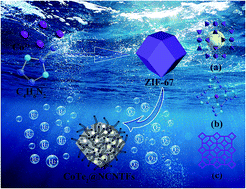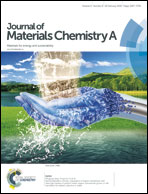Metal–organic framework derived CoTe2 encapsulated in nitrogen-doped carbon nanotube frameworks: a high-efficiency bifunctional electrocatalyst for overall water splitting†
Abstract
Developing highly active electrocatalysts with low cost and high efficiency for the hydrogen evolution reaction (HER) and oxygen evolution reaction (OER) is essential for water splitting. In this work, we for the first time report a high-efficiency electrocatalyst cobalt telluride encapsulated in nitrogen-doped carbon nanotube frameworks (CoTe2@NCNTFs) derived from metal–organic framework ZIF-67, which was synthesized via a straightforward telluride process under a hydrogen atmosphere. Notably, benefiting from the hollow polyhedron carbon nanostructure with large surface area, high conductivity, fast electron transport, and open channels for effective gas release, the as-synthesized electrocatalysts exhibit remarkable catalytic activity, with overpotentials of 330 mV and 208 mV toward the OER and HER at a current density of 10 mA cm−2 in 1.0 M KOH solution, respectively. Moreover, when CoTe2@NCNTFs was fabricated as an alkaline electrolyzer in basic solution, overall water splitting was achieved with high efficiency, which was comparable to the integrated performance of the commercial IrO2 and Pt/C catalyst couple. Our work provides a way for developing efficient noble-metal-free catalysts via rational surface engineering.



 Please wait while we load your content...
Please wait while we load your content...